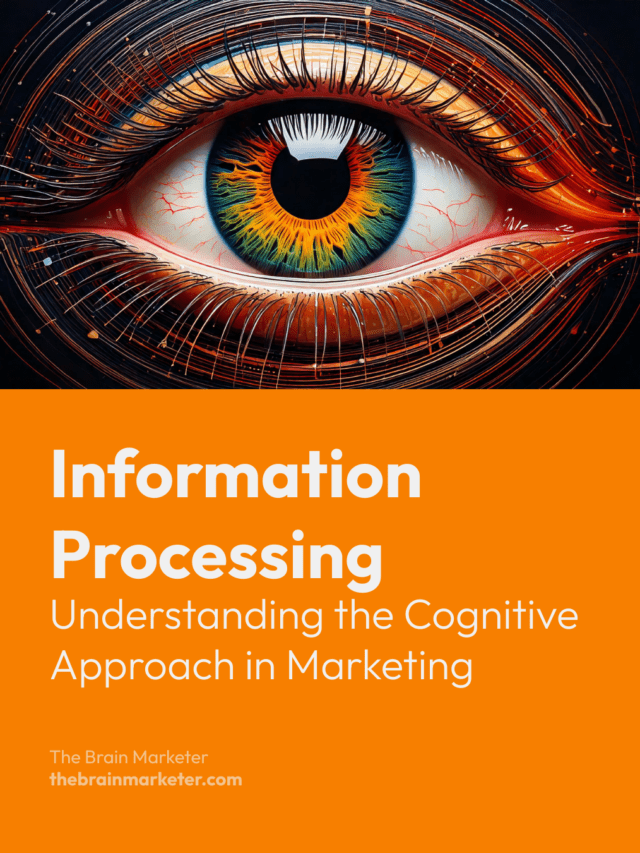Understanding how the brain handles information is essential for marketers seeking to influence attention, memory and decision-making. Rooted in cognitive psychology, the information processing model explains how we absorb, organize and act on stimuli, mirroring how a computer processes data.
This article explores the cognitive mechanisms behind information processing and how they directly shape consumer behavior, brand recall and marketing effectiveness.
🎙️ Unpack the Topic with this Podcast
What Is Information Processing?
The information processing approach views the brain as a system that receives input, encodes meaning, stores it in memory and produces output, just like a computer. Influenced by cognitivism and computing theory, this model sees the mind as software and the brain as hardware (Newell & Simon, 1972).
Cognition in this framework can be sequential (step-by-step) or parallel (simultaneous). Both forms help explain how consumers interpret messages, recall brands and make choices.
The Five Stages of Information Processing
1. Input
Sensory data enters through sight, sound, touch or other stimuli. In marketing, this might include a logo, a jingle or packaging texture.
2. Encoding
The brain assigns meaning by linking information to prior knowledge or emotional context. A familiar logo can instantly trigger stored associations.
3. Storage
Relevant information is stored in short- or long-term memory. Messages that are emotional or repeated are more likely to be retained.
4. Retrieval
When making a decision, the brain recalls stored information. This determines which brands come to mind at the point of purchase.
5. Output
The final stage is action, such as clicking, engaging or making a purchase.
Sequential vs. Parallel Processing
Sequential Processing
Cognitive tasks are handled one step at a time. Consumers focus on individual features, like comparing product specs. This is common in high-involvement decisions.
Parallel Processing
Multiple inputs are handled simultaneously. In-store browsing, hearing music and remembering a shopping list are processed in parallel. Low-involvement purchases often follow this mode.
Marketing takeaway: Match message complexity to the audience’s processing mode—linear for focus, layered for distraction.
Centralized vs. Decentralized Attention
Centralized Processing
Occurs when attention is focused. Think of watching a video ad or reading an in-depth review.
Decentralized (Distributed) Processing
Attention is divided, such as glancing at ads while scrolling social media or driving past a billboard.
Marketing takeaway: Centralized attention allows depth; decentralized requires quick, emotionally resonant messages.
How Information Processing Shapes Consumer Behavior
1. Attention and Sensory Input
With thousands of stimuli competing for attention, capturing the input stage is critical. Visuals, sound and movement matter.
Example: Bright visuals or sharp audio in TikTok ads break through clutter and activate attention circuits (Pieters & Wedel, 2004).
2. Memory and Brand Recall
Repetition and emotional consistency improve encoding and storage. The more often a brand appears in a meaningful context, the stronger its recall.
Example: Nike’s “Just Do It” campaigns build lasting impressions through consistent, motivational storytelling.
3. Decision-Making and Cognitive Load
Excess information can overwhelm working memory. Known as cognitive overload, it impairs decision-making and lowers engagement.
Example: A clean, well-structured product page with clear calls to action minimizes friction and improves conversion (Sweller, 1988).
Conclusion: Turning Cognition Into Strategy
The information processing model offers marketers a roadmap aligned with how the brain naturally works. From capturing attention to easing decisions, smart design respects cognitive limitations and enables better consumer outcomes.
When campaigns move with—not against—the brain’s architecture, brands do more than inform. They connect, persuade and convert.
Key Takeaways
- The information processing model explains how consumers receive, store, and act on stimuli.
- Consumers toggle between sequential and parallel processing depending on context.
- Centralized attention supports detailed messaging; decentralized requires fast, clear cues.
- Brand recall improves through emotional consistency and message repetition.
- Reducing cognitive load creates a smoother, more engaging user experience.
Sources:
- Newell, A. & Simon, H.A. (1972). Human Problem Solving.
- Pieters, R. & Wedel, M. (2004). Attention capture and visual marketing. Marketing Science, 23(4).
- Sweller, J. (1988). Cognitive load during problem solving. Cognitive Science, 12(2).

Vincent Heimann is a marketing project manager and neuromarketing enthusiast. He founded The Brain Marketer to bridge neuroscience and marketing through accessible, science-based content. With over 10 years of experience in digital strategy, UX/UI and communication, he shares practical insights to help brands connect with the human brain — ethically and effectively

